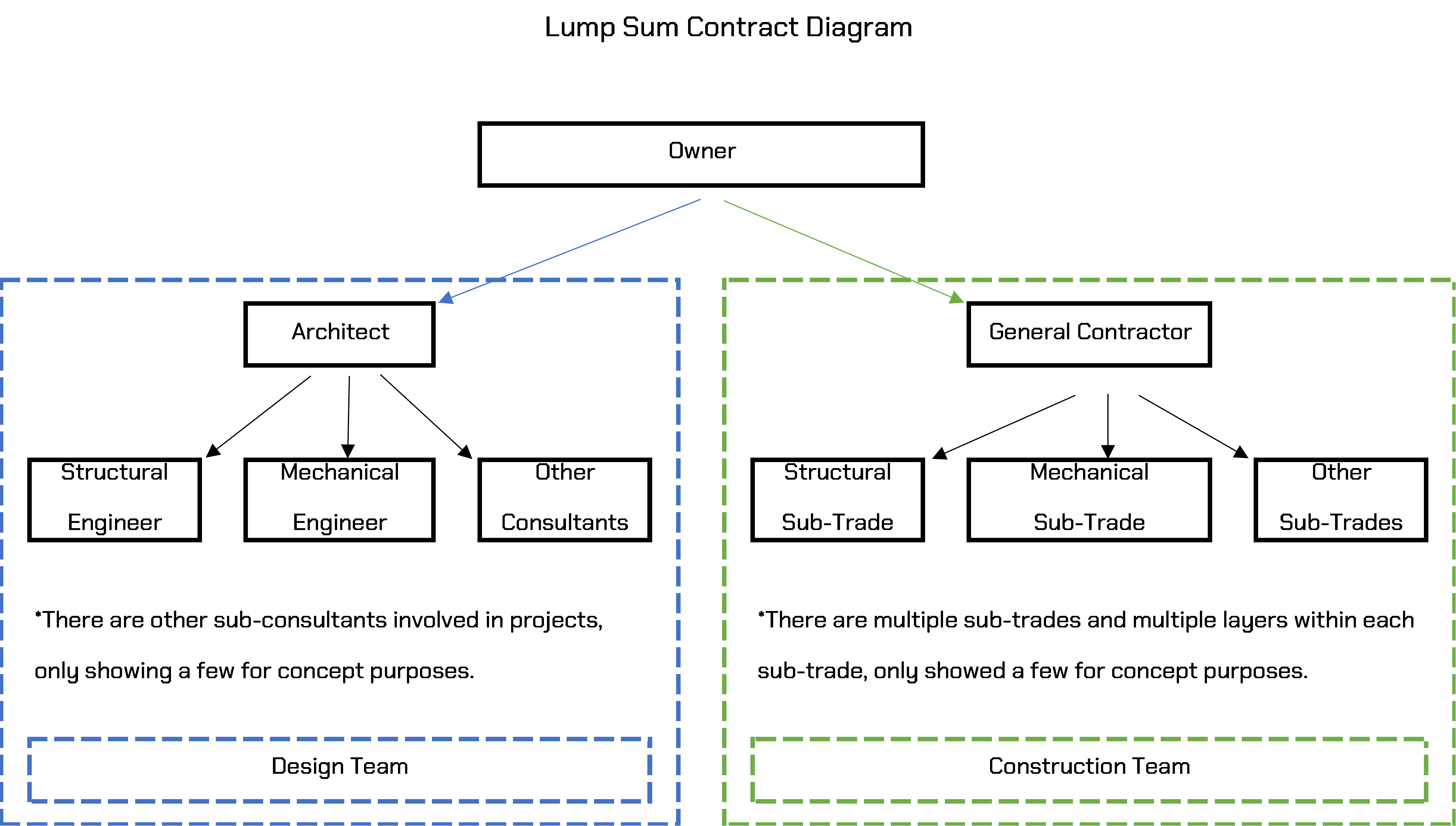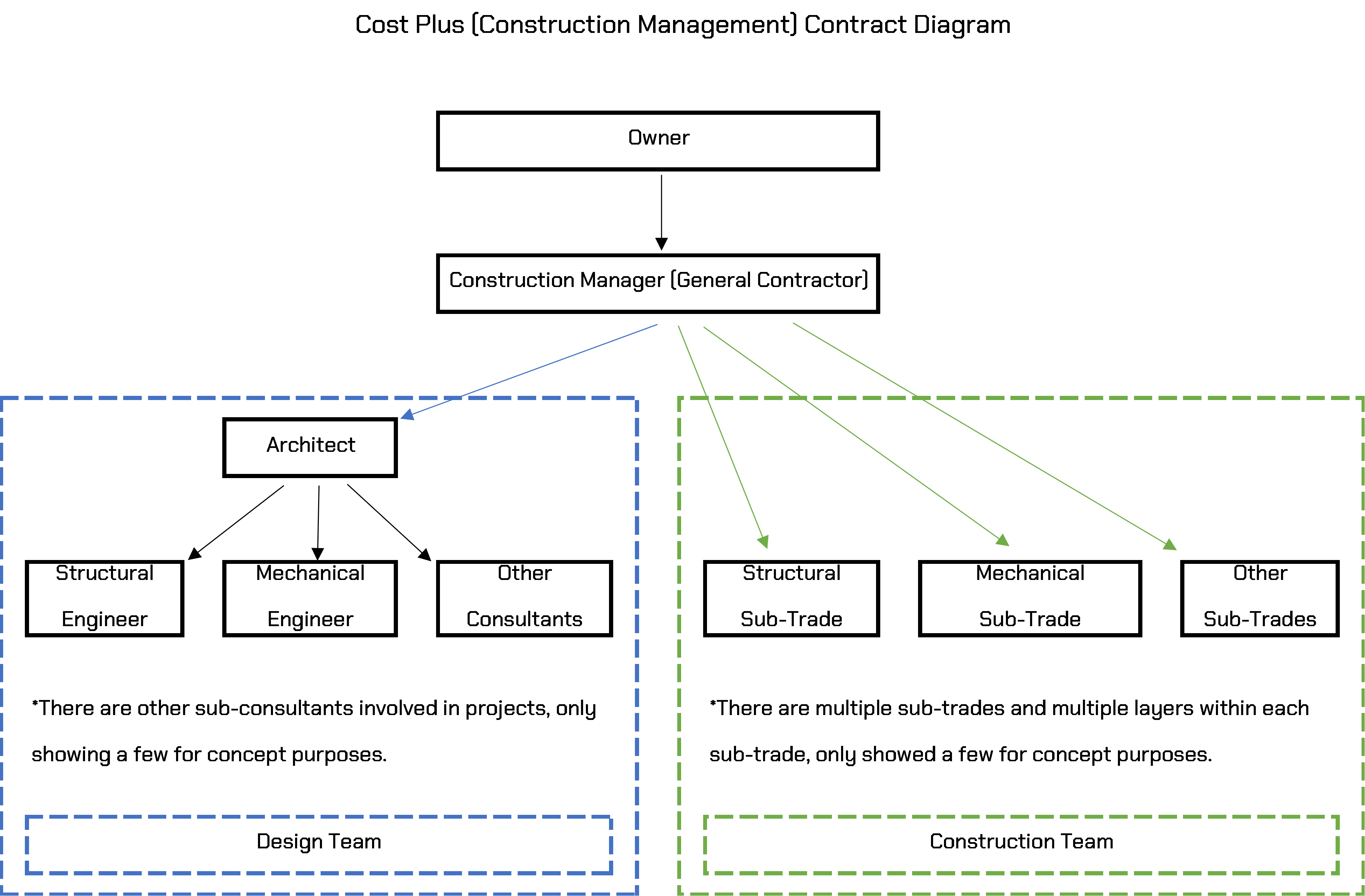In the construction industry, there are many types of construction contracts used to complete projects. This article will highlight some of the main types of contracts used in the industry along with advantages / disadvantages from the project owner’s point of view.
Lump Sum Contracts
Lump sum contracts (often referred to as bid & spec projects) are the most common type of contracts used in the construction industry. These are used when a clearly defined scope of work is established.

The owner hires an architect which leads the design of the project, and the architect hires additional disciplines (i.e. a Mechanical Engineer) as required to complete the design. Architects will also monitor the construction of the project, and allocate funds appropriately as they approve the completion progress of the project as it gets constructed.
Once the design is completed, the project documents are compiled, and sent out for competitive pricing. When the project documents are completed and well prepared, there shouldn’t be any major issues with the construction of the project.
Advantages of the Lump Sum Contracts
Using the lump sum method has many advantages for the owner. One of the key advantages is a single price to manage. There is no need to manage multiple sub-trades as everything is going through the general contractor for all construction aspects, and the architect is looking after all the design items. By having a single price, this makes it easier to finance as the banks will see the total expected cost (excluding change orders), which will vary depending on the design accuracy and the changes requested by yourself, the owner.
Going with the lump sum method also allows for easier comparison of the prices, as all prices received should be for identical scope. Going with the lump sum method also allows for multiple contractors to look at the project and generally provide free estimates of the work to be completed.
Disadvantages of the Lump Sum Contracts
There are a few disadvantages which may apply to your project if you choose to go the lump sum method. If the design is not completed properly, or there is a lack of coordination within the design team, there could be multiple changes required to accommodate the project. This will increase the project cost and potentially extend the project timeline, depending on the changes required. On these projects, multiple contractors will compete to win the project and the lowest price always wins. While this sounds attractive to an owner, there is a catch, most contractors will have to win the project with minimal profit, therefore contractors may try to get all changes they can approved in order to maximize their profit. For example, there could be constructability issues with the design that could be resolved earlier if the work was coordinated more closely. Often sub-trades are too laser focused with their own scope to coordinate with other sub-trades, which can cost money to the owner if there are inconsistencies in the design between different disciplines.
This means that all changes required to have your project completed, whether it’s a design issue, or an owner requested change, will most likely cost more money out of your pocket, which may require meetings with investors/banks for additional funds.
With this type of project, the owner is less involved in the design and construction process, which might be what the owner desires, however this may lead to conflict when changes are requested between the owner and the design/construction team.
With a lump sum project, it is hypercritical to have a good design team and have a clear idea of your completed project from the start to limit the changes and keep your project cost at a minimum, and as close as possible to the initial budget.
Cost-Plus Contract
Cost plus contracts allows more flexibility with the project scope from the owner’s point of view, and/or the scope of work is not clearly defined from the start. The structure for this type of project could be as shown above in the lump sum contract diagram, however often it will be as illustrated below here.

Advantages of Cost-Plus Contracts
Some of the advantages of this type of contract, it allows for the owner to select the construction team he desires to maintain the final quality of the project, specially if there is a relationship that was built on previous projects, and the outcome was as expected.
This also provides the owner with unlimited flexibility of the project as the scope of work can be fluid, and the construction team is there on a cost plus basis, which paying for all costs plus a markup which is pre-determined.
All changes to the project will also be applied on a cost-plus basis, with a pre-determined mark-up. The contractor is often pre-selected prior to the pricing/scope being finalized, and should be comfortable with the agreed rates, which will significantly reduce the cost of changes required, as they should be comfortable with their rates and don’t have to try and maximize their profit at every opportunity they have.
Disadvantages of Cost Plus Contracts
Going the cost-plus method has it’s challenges also, with one of the main concerns being the total project price. The construction team is typically selected prior to the design completion, which the project cost may spiral out of control. This is commonly a main concern for the banks and/or investors, if you need financing, as you’re building a project with no total pricing agreed upon, which can easily be increased due to design challenges or owner’s requested changes. The bank may see this as if you’re issuing a blank cheque to the construction team for the completion of your project. This also means the owner is taking all the project risks, which may arise as the project is taking shape since the design can be very fluid, and the changes can involve some previously completed work which you’re paying to get the work done twice.
Another key item to be aware of when using cost plus contracts is to try and limit the number of levels of sub-trades involved as contractors and sub-contractors are typically allowed a mark-up (typically 5-10%) on sub-trades for overhead, and another 5-10% for profit. General contractors will typically prefer to have one mechanical sub-trade which will hire all sub-trades on the mechanical side as it makes his life easier, however there is a premium to pay for this. A general contractor’s job is to coordinate the sub-trades, and should hire all sub-trades for their respective disciplines directly. The illustration below will highlight the cost difference by simply adding one level as a prime mechanical contractor. General Contractors will prefer scenario #2, but keep in mind this applies for all aspects of your project (structural, mechanical, electrical, to name a few), this makes the price climb quickly. In the example below, if there is a prime mechanical contractor which is responsible for all mechanical components, since the general contractor wants a single point of contact for the mechanical to make his life easier, you as an owner pays almost $180,000.00 on $2M, which is unnecessary. Keep in mind that general contractors will prefer scenario 1 when using the lump sum method to keep their price down, so there is no reason they cannot achieve it when they are in a cost-plus contract.

Cost Comparison between Scenario 1 and Scenario 2

Guaranteed Maximum Price (GMP)
This is commonly used when a vague scope of work is provided but there is no defined drawings or specifications. This may sound like an interesting type of contract initially, but there are items to be aware of before selecting this type of contract.
Advantages of using a guaranteed maximum price contract, are as follows:
- The pricing is agreed upon upfront and there will be no additional costs, only potential savings if there are savings to be found, they usually are distributed between the owner and the design/construction team.
- Guaranteed maximum price contracts involve all parties involved to save money, as the construction team keeps a portion of the savings. But be careful with this, more in the disadvantages…
- Cost overruns are the construction team’s problems (general and sub contractors). There is no change order for additional funds, only change orders for savings.
- Accelerated schedules usually benefits all parties involved, as the contractor and sub-contractors want to get the project done as soon as possible. This means your project should be completed on-time or ahead of time.
Disadvantages of using a guaranteed maximum price contracts are as follows:
- When issuing a contract of this type, contractors know the risk is on them 100% where there is risk, there is money accounted for those risks. As an owner, you’re paying the contracting team to take care of all risks involved, which may end up costing you more money as no one is in business to lose money. Typically, a contractor will allow a larger contingency fund to cover for unexpected costs as they are responsible for all additional costs.
- This type of contract limits the owner of all changes they may want on the project, as if it cost more money, the contractor will be opposed to any changes which costs more money.
- Changes may be done for the sake of saving money, however this may change the end result and the owner may not get the finished product he wanted.
- The contractor will find ways to save money and expand their bottom line profit. This may significantly affect the final product quality, and you may not be happy with the end results.
Conclusion
Different types of project will have advantages of using a specific type of contract, however all types of contracts benefit having a 3rd party cost consultant involved. Having a 3rd party cost consultant early on the project to reduce or eliminate the project budget increase(s) is always a good idea. If you’re aware of the project cost early in the project, this enables you to align the project for your specific needs, and not removing wanted items during the construction because of budget constraints. Hiring a 3rd party cost consultant for a small fee will make you aware of the project cost in the early stages, which will reduce the cost of changes which may be required to accommodate your budget. This will also reduce or eliminate the budget increases which may require additional financing through the bank or investors. If leases or sold spaces for your project are already signed, it may put you, the owner, in a tough financial position as the revenue is already determined for your project, and your cost is increasing. Don’t let one of your biggest investments become one of your worst investments, hire a 3rd party cost consultant which will not benefit from changes in the project financially, working to put money in your pocket and give you the final result you want, not draining your contingency funds and lining the contractors pockets as the project progresses.
We have omitted the Construction Management method in this article simply because there is too much information regarding construction management contracts and an article will be released focusing on Construction Management.
Hire us for your budgets and keep funds in your pockets, with the final product you desire, don’t settle on your largest investments with items you didn’t want for a price you shouldn’t pay. Move Mech Consulting provides precise budgets, disruptively precise budgets. Contact us at [email protected] to see how we can assist you for your construction needs. Visit our website www.movemech.ca for more information.
